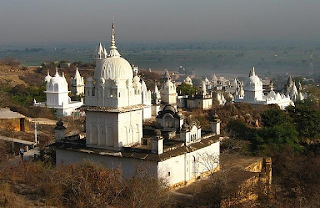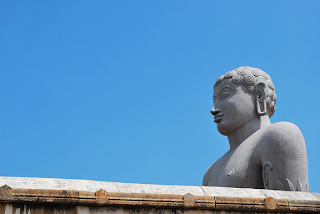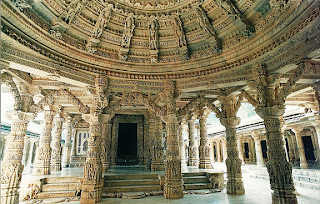Seven amazing Jain Temples and when they were built...
Lal Mandir
Located just opposite the massive Red Fort, the Shri Digambar Jain Lal Mandir is the oldest and best known Jain temple in Delhi. Originally built in 1526, the temple has undergone many alterations and additions in the past and was enlarged in the early 19th century. The imposing red sandstone temple is also known as Lal Mandir.
Sonagiri
The small town of Sonagiri (literally, the golden peak) is situated on a hill in central India. Several spotless white Jain temples are scattered around Sonagiri. Both pilgrims and tourists are required to climb the 300 steps to the top bare-footed. Once at the top, travelers can marvel at the view of countless white temples and chhatris (domes) whichever way you look.
Khajuraho Jain Temples
The village of Khajuraho is one of the most popular tourist destinations in India. Its numerous Hindu and Jain temples are famous for their erotic sculpture. The temples were built over a span of 200 years, from 950 to 1150. During the Chandella rule, Khajuraho was home to a large and flourishing Jain community. The Jains apparently lived on the east side of town and a number of Jain temples have survived in this part of Khajuraho. Two of the large temples still stand in a good state of preservation.
Gomateshwara Temple
The monolithic statue of Gomateshwara stands on a hill in the city of Shravanabelagola. Gomateshwara was the second son of Lord Adinatha, the first of the 24 Tirthankara (enlightened human). The 17.38 meter (58 ft) high monolithic stone statue is regarded as one of the largest monolithic statues in the world. It was created around 983 AD by Chavundaraya, a minister of the Ganga Kingdom. Once in 12 years the Mahamastakabhisheka festival is held and the statue of Gomateshwara is bathed in milk, curds, ghee, saffron and gold coins.
Dilwara Temples
Located near Mount Abu (Rajasthans’ only hill station), the Dilwara temples are world famous for their stunning use of marble. The ornamental detail spreading over the minutely carved ceilings, doorways, pillars and panels is simply amazing. There are 5 Jain temples here, each with its own unique identity and named after the small village in which it is located. All the temples were built by the Chalukya dynasty between the 11th and 13th centuries.
Palitana
The city of Palitana is a major pilgrimage center for Jains. The temples of Palitana are considered the most sacred pilgrimage place in Jainism. There are hundreds of Jain temples located on the sacred Mount Shatrunjaya, exquisitely carved in marble. They were built by generations of Jains over a period of 900 years, from the 11th century onwards. The top is reached by climbing 3,572 steps, a heavy 2 hour accent.
Ranakpur Temple
Dedicated to Adinatha, the Jain Temple in Ranakpur rises majestically from the slope of a hill. The temple is supported by over 1444 marble pillars, carved in exquisite detail. The pillars are all differently carved and no two pillars are the same. The construction of the temple and quadrupled image symbolize the Tirthankara’s conquest of the four cardinal directions and hence the cosmos. The dating of this temple is controversial but it was probably built between the late 14th and mid-15th centuries.





















No comments:
Post a Comment